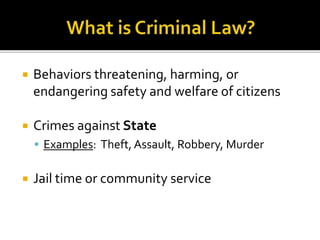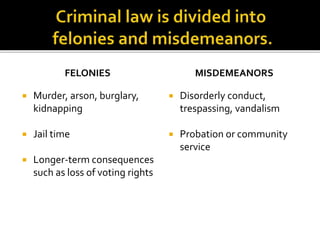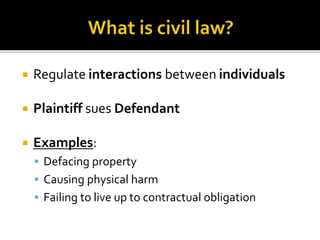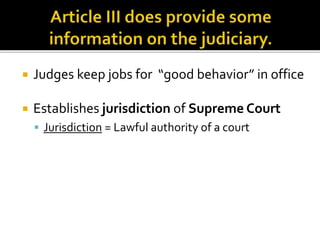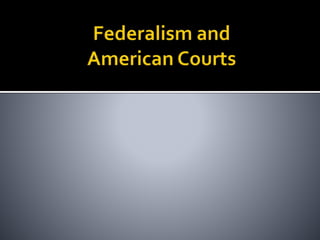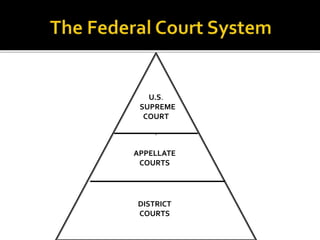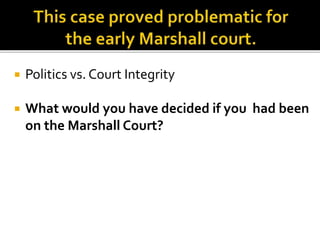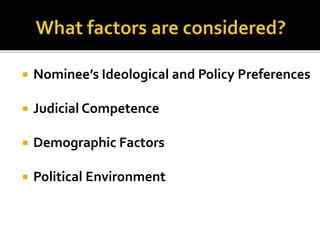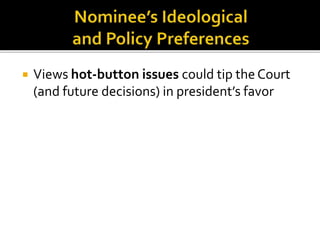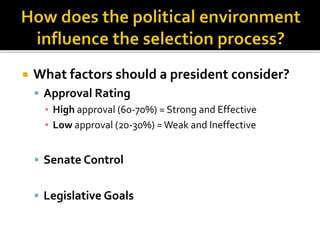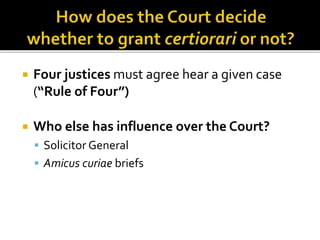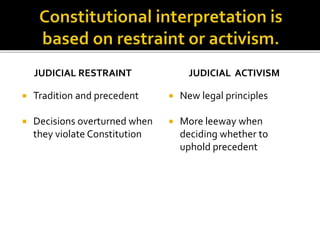Courts
- 1. POL 140 Fall 2014
- 4. Provide Security Provide Predictability Conflict Resolution Reflect and Enforce Conformity to Societal Values Distribute Benefits and Allocate Costs of Society
- 6. U.S. system based on English common law Importance of precedent Sixth Amendment "In all criminal prosecutions, the accused shall enjoy the right to a speedy and public trial, by an impartial jury..”
- 8. SUBSTANTIVE LAW Actions we can and cannot legally perform under law PROCEDURAL LAW Establishes procedures used to conduct the law
- 9. Behaviors threatening, harming, or endangering safety and welfare of citizens Crimes against State Examples: Theft, Assault, Robbery, Murder Jail time or community service
- 10. FELONIES Murder, arson, burglary, kidnapping Jail time Longer-term consequences such as loss of voting rights MISDEMEANORS Disorderly conduct, trespassing, vandalism Probation or community service
- 11. Regulate interactions between individuals Plaintiff sues Defendant Examples: Defacing property Causing physical harm Failing to live up to contractual obligation
- 12. Statutory Law: Laws made by federal or state legislatures Examples: Acts of Congress, public laws, etc. Administrative Law: Laws established by bureaucracy Examples: Food products, tax deductions, etc.
- 14. Article 3, Section 1: “The judicial power of the United States, shall be vested in one Supreme Court, and in such inferior courts as Congress may from time to time ordain and establish.”
- 15. Judges keep jobs for “good behavior” in office Establishes jurisdiction of Supreme Court Jurisdiction = Lawful authority of a court
- 16. Founders had little experience with judiciary Violating authority of state courts
- 17. How many members will be on the Supreme Court? Will there be lower courts? If so, what will they look like? What actual powers will the judiciary have?
- 19. STATE SUPREME COURT APPELLATE COURT TRIAL COURT
- 20. Trial Court Cases heard for first time under original jurisdiction Court of Appeals Hear appeals from trial courts State Supreme Court All decisions are final—unless involve a federal question and can then move to federal court system
- 21. U.S. SUPREME COURT . APPELLATE COURTS DISTRICT COURTS
- 22. DISTRICT COURTS Trial courts of federal system 94 district courts Original jurisdiction over Constitutional questions Criminal and civil cases heard at this level APPELLATE COURTS 12 Circuit Courts Appellate jurisdiction; Cases come from other courts Decisions by three judges
- 26. Politicization occurs when we bring something— (e.g. public interest) into politics Politicization affects all branches of govt. Bigger issue for courts than other branches
- 28. Chief Justice John Marshall
- 31. Politics vs. Court Integrity What would you have decided if you had been on the Marshall Court?
- 32. Establishment of Judicial Review Power of courts to determine whether a law or parts of laws are constitutional Check on President and Congress
- 35. Since the 1930s, the Supreme Court has been active on a number of important political and social issues.
- 37. Gerald Ford John Paul Stevens
- 38. Nominee’s Ideological and Policy Preferences Judicial Competence Demographic Factors Political Environment
- 39. Views hot-button issues could tip the Court (and future decisions) in president’s favor
- 40. Nominating someone seen as generally qualified can quicken confirmation process George W. Bush nominating White House Counsel Harriet Miers for a vacancy on the Supreme Court. Miers eventually withdrew her nomination.
- 41. Thurgood Marshall Sandra Day O’Connor Sonia Sotomayor
- 42. What factors should a president consider? Approval Rating ▪ High approval (60-70%) = Strong and Effective ▪ Low approval (20-30%) = Weak and Ineffective Senate Control Legislative Goals
- 44. ORIGINAL JURISDICTION Straight to Supreme Court Many types of cases APPELLATE JURISDICTION Heard on appeal from lower court Majority of cases Writ of certiorari : Court agrees to review a case on appeal
- 45. Four justices must agree hear a given case (“Rule of Four”) Who else has influence over the Court? Solicitor General Amicus curiae briefs
- 47. Legal Model Attitudinal Model Strategic Model
- 49. Focus on legal principles Justices’ legal expertise important to decipher correct interpretation of law How can the Constitution be interpreted?
- 50. JUDICIAL RESTRAINT Tradition and precedent Decisions overturned when they violate Constitution JUDICIAL ACTIVISM New legal principles More leeway when deciding whether to uphold precedent
- 52. Focuses on justices’ policy preferences How do we know what preferences are? Party of President making appointment Examples: George W. Bush; Barack Obama
- 54. EXTERNAL IMPACT Larger political environment INTERNAL IMPACT Reaching decisions between justices
- 56. Majority Opinion Plurality Opinion Concurring Opinion Dissenting Opinion
- 57. Opinion of the majority of justices stating why they ruled in a case If Chief Justice is in majority Chief Justice assigns majority opinion If Chief Justice is NOT in majority Associate Justice with most seniority assigns majority opinion
- 58. Opinion occurring in absence of majority Justices agree on decision but NOT legal basis Presents view held by “winning” justices
- 59. Opinion of one of more justices Agree with majority decision Disagree with majority’s reasoning
- 60. Opinion of one or more justices Disagree with the majority’s decision Disagree with reasoning behind it Important for “losing” justices








